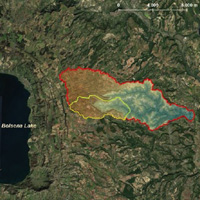Riparian vegetation as a marker for bankfull and management discharge evaluation: The case study of Rio Torbido river basin (central Italy)

Published:28 June 2021
Abstract Views: 1044
PDF: 687
HTML: 14
HTML: 14
Publisher's note
All claims expressed in this article are solely those of the authors and do not necessarily represent those of their affiliated organizations, or those of the publisher, the editors and the reviewers. Any product that may be evaluated in this article or claim that may be made by its manufacturer is not guaranteed or endorsed by the publisher.
All claims expressed in this article are solely those of the authors and do not necessarily represent those of their affiliated organizations, or those of the publisher, the editors and the reviewers. Any product that may be evaluated in this article or claim that may be made by its manufacturer is not guaranteed or endorsed by the publisher.
Similar Articles
- Mario Pirastru, Marcello Niedda, Mirko Castellini, Effects of maquis clearing on the properties of the soil and on the near-surface hydrological processes in a semi-arid Mediterranean environment , Journal of Agricultural Engineering: Vol. 45 No. 4 (2014)
- Johnny Moretto, Emanuel Rigon, Luca Mao, Lorenzo Picco, Fabio Delai, Mario Aristide Lenzi, Medium- and short-term channel and island evolution in a disturbed gravel bed river (Brenta River, Italy) , Journal of Agricultural Engineering: Vol. 43 No. 4 (2012)
- Lorenzo Picco, Alessia Tonon, Riccardo Rainato, Mario Aristide Lenzi, Bank erosion and large wood recruitment along a gravel bed river , Journal of Agricultural Engineering: Vol. 47 No. 2 (2016)
- Giovanni Francesco Ricci, Faouzi Zahi, Ersilia D'Ambrosio, Anna Maria De Girolamo, Giuseppe Parete, Taha-Hocine Debieche, Francesco Gentile, Evaluating flow regime alterations due to point sources in intermittent rivers: A modelling approach , Journal of Agricultural Engineering: Vol. 53 No. 2 (2022)
- Alessio Cislaghi, Gian Battista Bischetti, Best practices in post-flood surveys: The study case of Pioverna torrent , Journal of Agricultural Engineering: Vol. 53 No. 2 (2022)
- Maria Elena Menconi, David Grohmann, Statistical assessment of vegetation dynamics within protected areas using remote sensing data , Journal of Agricultural Engineering: Vol. 44 No. 1 (2013)
- Ameneh Sobhani, Shawkat B.M. Hassan, Giovanna Dragonetti, Raffaella Balestrini, Mauro Centritto, Antonio Coppola, Alessandro Comegna, Comparing actual transpiration fluxes as measured at leaf-scale and calculated by a physically based agro-hydrological model , Journal of Agricultural Engineering: Vol. 54 No. 3 (2023)
- Volodymyr Bulgakov, Simone Pascuzzi, Semjons Ivanovs, Volodymyr Kuvachov, Yulia Postol, Francesco Santoro, Viktor Melnyk, Study of the steering of a wide span vehicle controlled by a local positioning system , Journal of Agricultural Engineering: Vol. 52 No. 3 (2021)
- Ziyan Fan, Lijun Li, Zicheng Gao, Fuzzy neural network PID control design of camellia fruit vibration picking manipulator , Journal of Agricultural Engineering: Vol. 54 No. 2 (2023)
- Eliseo Roma, Pietro Catania, Mariangela Vallone, Santo Orlando, Unmanned aerial vehicle and proximal sensing of vegetation indices in olive tree (Olea europaea) , Journal of Agricultural Engineering: Vol. 54 No. 3 (2023)
You may also start an advanced similarity search for this article.

 https://doi.org/10.4081/jae.2021.1140
https://doi.org/10.4081/jae.2021.1140 











